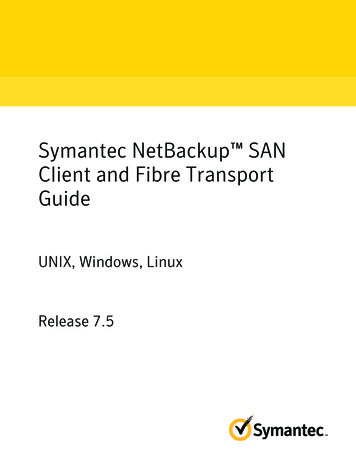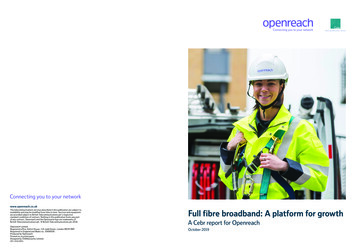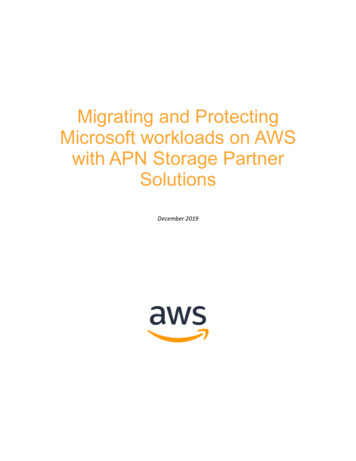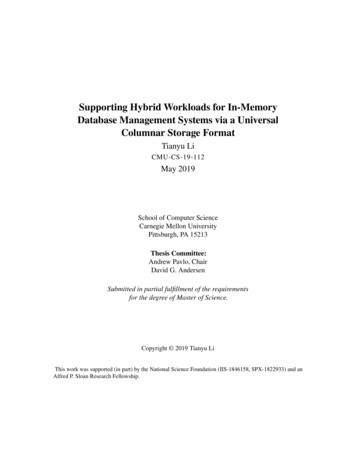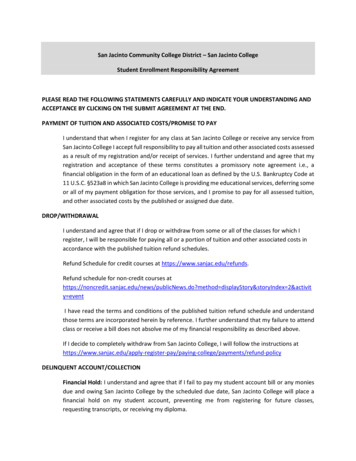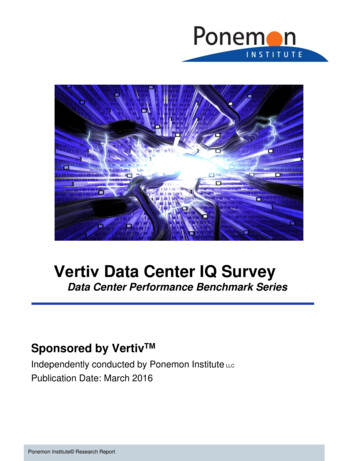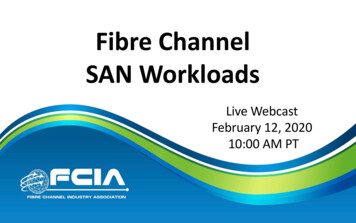
Transcription
Fibre ChannelSAN WorkloadsLive WebcastFebruary 12, 202010:00 AM PT
Today’s PresentersMark JonesBroadcomModeratorNishant LodhaMarvellPresenterBarry MaskasHPEPresenter
About the FCIA The Fibre Channel Industry Association (FCIA) is a mutual benefit,non-profit, international organization of manufacturers, systemintegrators, developers, vendors, and industry professionals, andend users– Promotes the advancement of Fibre Channel technologies and products thatconform to the existing and emerging T11 standards– Maintains resources and supports activities to ensure multi-vendorinteroperability for hardware, interconnection, and protocol solutions– Provides promotion and marketing of FC solutions, educational awarenesscampaigns, hosting public interoperability demonstrations, and fosterstechnology and standards conformancehttps://fibrechannel.org/3
Agenda Fibre Channel and Business Critical ApplicationsUnderstanding FC SAN Application WorkloadsSAN Application Workloads I/O fingerprintsHow FC Delivers on Application Workloads
Key Tenants of Fibre Channel Purpose-built as network fabric for storage and standardized in 1994, FibreChannel (FC) is a complete networking solution, defining both the physicalnetwork infrastructure and the data transport protocols. Features include:– Lossless, congestion free systems—A credit-based flow control systemensures delivery of data as fast as the destination buffer can receive, withoutdropping frames or losing data.– Multiple upper-layer protocols—Fibre Channel is transparent and autonomousto the protocol mapped over it, including SCSI, TCP/IP, ESCON, and NVMe.– Multiple topologies—Fibre Channel supports point-to-point (2 ports) andswitched fabric (224 ports) topologies.– Multiple speeds—Products are available supporting 8GFC, 16GFC, and 32GFCtoday.– Security—Communication can be protected with access controls (port binding,zoning, and LUN masking), authentication, and encryption.– Resiliency—Fibre Channel supports end-to-end and device-to-device flowcontrol, multi-pathing, routing, and other features that provide load balancing, theability to scale, self-healing, and rolling upgrades.
How Fibre Channel Compares?Source: Brocade.
FC: Low Overhead FC has low overhead in terms of protocol stack Enables FC to deliver low latency and low CPU Utilization per I/ONoOverhead!
Fibre Channel WorkloadsMarket Drivers Server virtualization Increasing serverworkloads Applications growth Multi Core processors NVMe PCIe 4.0 SecurityApplications High-end backupDisaster recoveryEnterprise DatabasesDense VirtualizationBig DataRemote ReplicationBenefits Higher performance Predictableperformance Reliability Low Latency Virtualization Aware High AvailabilityStorage is a critical component of Enterprise Applications
Why is Storage and I/O Important?èBusiness Critical Application expectations from Storage:– PerformanceUniform application response time under varying workloads– ReliabilityProtection of your data from data loss– AvailabilityData is available to the usersèImperative to understand that the full stack for Fibre Channel I/O:DBAppsFC-NVMeOSCPUPCI BusFC HBASwitchCablingArrayCacheDisk/NVMe
Key Metrics for Measuring I/O?ThroughputIOPSLatencyBandwidth, DataTransfer RateMeasured in MB/sSequential Large BlockWorkloadsTransactional PerformanceMeasured in Kilo or MillionRandom Small BlockWorkloadsResponse TimeMeasured in microsecondsRound Trip I/O Completionfor sensitive workloadsMaximum Throughput or IOPS latency continues to with constant throughput
Key Metrics for Specifying I/O? Pattern:– Sequential: Data is read/written from the IO subsystem in the same order as it is stored on the IOsubsystem.– Random: Data is read/written from the IO subsystem in a different order as it is stored on the IOsubsystem. Size:– Specifies size of I/O operations– 512Bytes to 1MBytes range Access:– Specifies Read, Write, or mix of both operations Queue Depth:– The number of outstanding I/O operations in flight
FC Workloads – Data Block Size SurveyApplications4K8K16K32K64KOracle DatabaseüüüüüMicrosoft SQLüüüüMongoDB databaseHPC for media,genomics, and lifesciences512K 1024KüüüüüMicrosoft ExchangeData reductionüüüSource: Marvell survey FC applications utilize 4KB or larger block– 95% reads; 85% writes– Almost half (45% ) are 4KB & 8KB block sizesSource: e-modalities-on-pure-storage-flasharrays/ FC Workloads typically utilize 4KB orlarger block size– 5 of 6 applications use 8KB block size– 512B micro benchmarks don’t representreality
I/O FingerprintsAnalytics, Business Intelligence, Data Warehouse, OLAP etc. Read-intensive, large block sizes Typical 64-256KB sequential reads (table and range scan) 128-256KB sequential writes (bulk load)Transactional or OLTP Processing Read (70%) –Write (30%) -intensive, small block sizes Typically, heavy on 8KB random read / writesVirtualization and the I/O Blender Effect At the hypervisor and storage level The I/O from multiple VMs gets mixed up – as if it were run through a blender The storage system gets random I/O, even though it started out as sequential I/O per VM Virtualization Services e.g. vMotion; HA / Fault Tolerant operationBursty: Monday morning login problem with virtual desktops, background tasks etc.
Business Critical Apps - High Availability Business Critical applicationsMulti Pathing SoftwareMulti Pathing Softwareneed reliable storageServer AServer B In Fibre Channel this is typicallyFC-NVMeFC-NVMeFCachieved by:HBAHBAHBAHBA Servers– Multiple Host Bus Adapters Fibre Channel SwitchesFC Switch– Two switches forFC Switchredundancy Fibre Channel Storage Array– Two Controllers forDisk Drivesredundancy– Multiple disk drives per arrayControllerController– Remote ReplicationFC Storage Arraybetween arrays across sitesFC
New! FC-NVMe!FC-NVMeFabricIncreased Virtualization Density“NVMe” Over Fibre ChannelTransportNVMeNativelyMoreContent Video,Big DataChannelReliable,Secure,Greater OPEXEfficiencyAvailableover FibreLow Latency, High ThroughputNon-Volatile Memory “Express”Low LatencyLeverage Existing Investmentsin FibreHigh Speed FlashStorageChannelFC-NVMe v2 near standardizationEcosystem Ready
FC-NVMe – Delivers NVMe NativelyTraditional FC SAN ApplicationsTraditional FCFCFCSCSISCSISAS SSDLow Latency FC SAN ApplicationsNVMe over FC, NativelyFC-NVMeFCNVMeNVMeNVMe
Agenda FC Delivers on Application Workloads The Stack and Protocol that enables these workloads Block Level storage virtualization– Multi Pathing, NPIV, Virtual SANs, VMIDs, zoning, B2B Credits, FCIP Upcoming standards that further enhance SANs
What is a Workload?A workload is the combined I/O of the interfaces with network and storageinfrastructures of a distributed application, often serviced by multipleservers§ For example, an application workload interacts with a web-server, oneor several database servers as well as other application servers.§ The combination of all of these servers and the associated storageand network I/O makes up that application’s workload.It’s all about the workloads and enabling a business as a whole.§ OLTP, DB requires random read/write performance & consistently lowlatency§ Healthcare, finance require resilient connections§ Virtualization requires both performance & resiliency
Workloads PlatformLOBownerApp workloadsVMadminCloudadminBig Data/AIDatascientistDevOpsAutomation connectorsInfrastructureadminCloud data managementData lifecycleContext-awareCatalogGlobal intelligence enginePredictive analyticsWorkload fingerprintGlobal learningWorkload-optimized infrastructure: Any workload, any cloudMission-criticalGeneral-purposeSecondaryBig Data/AIRecommendationsAny cloudBig Data/AI
Many Different Software Stacks RunningBig Data - Open Source and/or Community SupportedWorkload:IoT: Car (simulated): MiNiFi, CARLA, ROS Edge (simulated): Edgent, MiNiFi, Zenko, TensorRT TensorFlow(GPU) Core: NiFi, KafkaReal-Time: Streams: Spark Streams, Flink Persist: Druid (timeseries), Aerospike, Redis, MemcacheD Inference: Spark/Beam, Flink/BeamBig Data: Storage: HDFS, HDFS-EC, Ceph S3, Scality S3 Batch Processing: Spark, HBaseDeep Learning: PyTorch, Chainer, Caffe2, MXnet, H2O.ai SparklingWaterand H2O.ai DeepWaterStorage Fabrics: Alluxio, Apache Ignite, WekaIOGPU Data Frame: Apache ArrowMonitoring & Alerting: Elasticsearch Stack, Prometheus, GraphiteGraphing: Grafana, KibanaGPU Analytics: Knime, GPU/MapDHPC: OpenMPIVisualization: Superset, Presto, HiveProxy/Load Balancer: NginxCI/CD: Jenkins, Git, GarretOrchestration & Automation: KubernetesPackaging: Ansible, HelmDeployment: Kubespray, HashicorpTerraformVirtualization: Hashicorp Vagrant and VirtualBoxContainerization: DockerInstallation: PXE, Kickstart, Hashicorp CobblerScheduling: AirflowHPC Cluster Management: Insight CMUSecurity: Kerberos Support, SSL Support, RBAC SupportKey Management: HashiCorp VaultGovernance, Risk & Compliance (GRC): Eramba
The V’s of BIG DataAny one, or all, of the following “V’s”, and driven by a 5th “V” Value.Businesses must be able to derive value from any investment they make in their dataü this is done through Machine Learning1. Volume Too much data to move around for processing (tens-of-petabytes, at a minimum)2. Velocity Processing Data in Motion3. Variety Lots of different data sources providing different kinds of data in different formats,not easily processed due to no universal format4. Veracity Difficulty deriving any intelligence or truthfulness of the dataIoT - A subset of Big Data that focuses on all the above-V’sü specifically the processing of very high velocity – very small data – at extreme scale.
Defining the Right Mix of Hybrid IT isChallenging Someone else’s datacenterLocal data centerProsPros– Maintain control of critical data– Optimize vital and complex applications– Strategic business control and securityCons– Over-provision for unpredictable demand– Complex to procure and provision– Requires capital outlayOn-Prem Cloud– Pay only for what you need– On-demand provisioning– Agile application developmentTrade-offsHosted CloudMulti-CloudCons– Unacceptable latency– One size fits all– Lock in and loss of economic control
Secure & Fast & ReliableF o r c e d Tr a d e o f f b e t w e e n A g i l i t y a n d R e s i l i e n c yOn-premiseFC SANStoragePublicCloudAgility & Simplicity
O r g a n i z a t i o n s– App-AwareF l y B l Resiliencyind with Inconsistent Latency atScaleThe problem todayIdeal shared storageBully neighborsUndesirableservice levelLatency asa % IO10%50%Overprovisioning100%Missed SLAsPredictable low latencyLatencyas a % IO10%50%100%Consistency at ScaleThe problem with performance today isn’t IOPS and throughput – it’sinconsistent latency due to multi-tenant workloads driving up overall responsetimes!One answer is to isolate mission critical apps.
Understanding Workload CharacteristicsWithout the proper tools, understanding the I/O requirements ofmulti-tier and multi-tenant workloads is difficult.– Comparing the impact of multiple, frequently changing workloads isalmost impossible and multi-tenancy adds to too varied latency. The same workload in a different company runs differently, eachcharacteristic demands something different from a storagesystem. The ability to capture workload I/O characteristics, analyze thatdata and regenerate it is a critical capability for data centers tomaster. Workload profiling enables organizations to troubleshoot andoptimize their current environment as well as plan for the future.
Cross-Stack Analytics for VMware EnvironmentsVMs/DBs/AppsNoisy NeighborDetermine if VMs are hoggingresources from another VMHost & Memory AnalyticsVisibility into host CPUand memory metricsComputeLatency AttributionIdentify root cause acrosshost, storage, or SANNetworkStorageInactive VMsTop Performing VMsVisibility into inactive VMs torepurpose/reclaim resourcesVisibility into Top 10 VMsby IOPs and Latency
Storage System AnalyticsDetailed performance overview of storage array
Flash Does Not Change StorageRequirements!Reducing risk with a comprehensive approach to data integrityHigh performanceScalabilityReliabilityDisaster recoveryFlash-optimized architectureScale out architecture withmultiple active/active nodesProven architecture withguaranteed high availabilityData protection with syncand async and multiple sitesEase of useData mobilityApplication integrationVMware, Oracle, MicrosoftHyper-V, SQL Server,Exchange integrationsDrive efficiencyExtend life and utilization Self-configuring, optimizing,of flash;and tuning110 % shared storage utilization vs. 20% per host, each with NVMedrive(s).Federate acrosssystems and sites
Flash LatencyStartFastStayFastAlwaysFastUp to 50%Lower LatencyAverage 200usLatency or BelowNear 100% within300us Latency125us avg. 4M IOPSMeasured by the host application using a storage class memory and flash storage system running a8KB Random read workload and all flash storage system running a 4KB Random read workload.
Tr u t h A b o u t a n N V M e S t o r a g e B a c k - e n dthe source of storage latencyLatencyMedia ControllerSoftware Media ControllerSoftware Media ControllerSoftware Media ControllerSoftware Media Controller SoftwareSATA, SAS HDDSATA NAND SSDSAS NAND SSDNVME NAND SSDNVME StorageClass Memory
Storage GrowthStorage growth is being driven by new and evolving workloads§ mobile computing§ Big Data and analytics§ business-oriented social media§ custom applications - virtualized§ cloud computing§ migration of legacy workloads to virtual infrastructure§ Migration of workloads back from the cloud to on-premisesü 41%1 of businesses surveyed brought at least one workload back on-premises in 2018Key requirements for storage infrastructure for which virtualization is a major driver of new requirements§ the need to scale out easily and quickly§ Flexable storage media and interconnect support – SSDs, HDDs, mixes of SSD and HDD, NVMe SSD, storage class memory, etc.§ leverage disparate information sources (and pull data in and out of those sources)§ support applications that are geographically distributed§ DevOps oriented and built to support advanced analytics§ storage infrastructure should provide highly available, secure data access, line-rate, non-blocking, high-speed throughput,multi-tenancy, and consistently low latency service times.§ Millions of IOPS and response times in microseconds instead of milliseconds§ Availability is not just about hardware; it's also about a holistic approach with hardware, software, management, and the rightarchitecture.1ESG Market Researchü Fibre Channel SAN is the bedrock of a holistic approach
Understanding Workload CharacteristicsBy identifying workload requirements and their I/O patterns, FC workloads can bemapped to storage and without ever needing to do a comparison to other protocols.ü However - it is important to gather actual performance metrics for best sizingresults.Each workload has unique characteristics, and each of these characteristics impacts latency, IOPSand throughput. These characteristics include:1.2.3.4.5.6.I/O Mix - is the workload read heavy, write heavy, balanced, or bursty?I/O type - does the workload write or read data sequentially or randomly?Data/metadata mix - does the workload read or manipulate metadata more so than actualdata?Block or file size distribution - does the workload write in small or large blocks?Data efficiency appropriateness - does the workload have highly redundant or compressibledata so that functions like deduplication and compression work effectively?Is the workload prone to specific hot spots?How do all of the above characteristics change over a relevant time period?
FC SAN AnalyticsLatency is a fundamental reason driving the choice for on-premises over cloud workloads.– There are serious operational, geopolitical, performance/latency, and regulatory details toconsider before finalizing locality decisions.– Applications that house very sensitive data, may want to reside on-premises and not beyond theconfines of a data center and the FC SAN.FC SAN Analytics can provide real time workload insight into the causes of performance degradation:Fibre Channel equipment suppliers have added in-line support to FC for FC-NVMe SANAnalytics that helps with understanding and troubleshooting workloads in real time.ü FC SAN Analytics programs offer visibility into I/O traffic between compute and storageinfrastructures including visibility into individual ports, switches, servers, virtual machinesand storage arrays.ü The information generated by FC SAN Analytics can be used to maintain a performancebaseline.ü A deviation from the historic trend can be used to generate alarms, resulting into proactivetroubleshooting.ü Workload monitoring provides insight into the causes of performance related problems.ü It is important to gather actual performance metrics for best growth and maintenanceplans.
FC SAN Analytics rationWorkloadpredictionForecastsystem loadCommunitylearningPredictperformance“What if”scenarios
FC SAN-based Benchmarks Can HelpBenchmarks can provide insights into and set moderate workload expectations. Benchmark set of programs taken from real workloads ;Examples:TPC-C simulates a complete computing environment and involves a mix of five concurrent transactions ofdifferent types and complexity.TPC-DS is the industry standard benchmark for measuring the performance of decision support solutions and ischaracterized by high CPU and I/O load as volumes of data are examined.Data Warehouse Workload can be represented by TPC-E and TPC-H:TPC-E is a “scalable” On-Line Transaction Processing (OLTP) workload using a real (not synthetic) Microsoft SQLServer database to model a brokerage firm and provides a transactional throughput numerical score.TPC-H is a decision support benchmark which consists of a suite of business oriented ad-hoc queries andconcurrent data modifications. Large volumes of data are examined and queried with a high degree ofcomplexity.VMmark 3 allows accurate and reliable benchmarking of virtual data center performance and powerconsumption.ü High random mix of I/O transfer sizesSPEC SFS 2014 designed to evaluate performance using file server end-to-end throughput and response time.
FC has Many Virtual Technologies§§§§§§§VSAN partitions of FC switches provide virtual isolation of a group of ports and their associatedtraffic, ports within each VSAN can be zoned to provide refined logical connectivity.VSANs can support Virtual Fabric Tagging Header which allows FC frames to be tagged with a VFIdentifier (VF ID) of the VF to which they belong – used to share an ISL with other VSANs.FC HBA ports (target or server) utilize NPIV - a FC feature whereby multiple FC node ports(N Port) IDs can share a single physical N Port and each can be zoned separately.Virtual Fibre Channel for Hyper-V guests uses FC HBA NPIV to map multiple N Port IDs to a singlephysical Fibre Channel N port. A new NPIV port is created with each virtual HBA.FC switch VSAN partitions and NPIV provisioned HBAs combine to enable a virtual FC system.Hyper-V guests directly access FC LUNs as if operating on a physical server.Virtual FC in Hyper-V guests includes support for related features, such as vSAN, live and quickmigration, MPIO, Import and Export, Save and Restore, Pause and Resume, and guest initiatedbackups.Hyper-V guestsFCF mode switch providesfabric login servicesstorageNPV mode switch proxies the FC login to the FCFswitch on behalf of each of the attached serverswhich then utilize NPIV WWNs in zones toconnect with storage volumes
NPIV Use CasesVirtualizationDatabasesMulti-TenantContainers
VMID for VMware FC SAN EnvironmentsDiagnosing the traditional wayLatency (ms)Where is this latencyspike coming
Feb 12, 2020 · 128-256KB sequential writes (bulk load) Transactional or OLTP Processing Read (70%) –Write (30%) -intensive, small block sizes Typically, heavy on 8KB random read / writes Virtualization and the I/O Blender Effect At the hypervisor and storage level The I/O from multiple VMs gets mixed up – as if it were run through a blender
